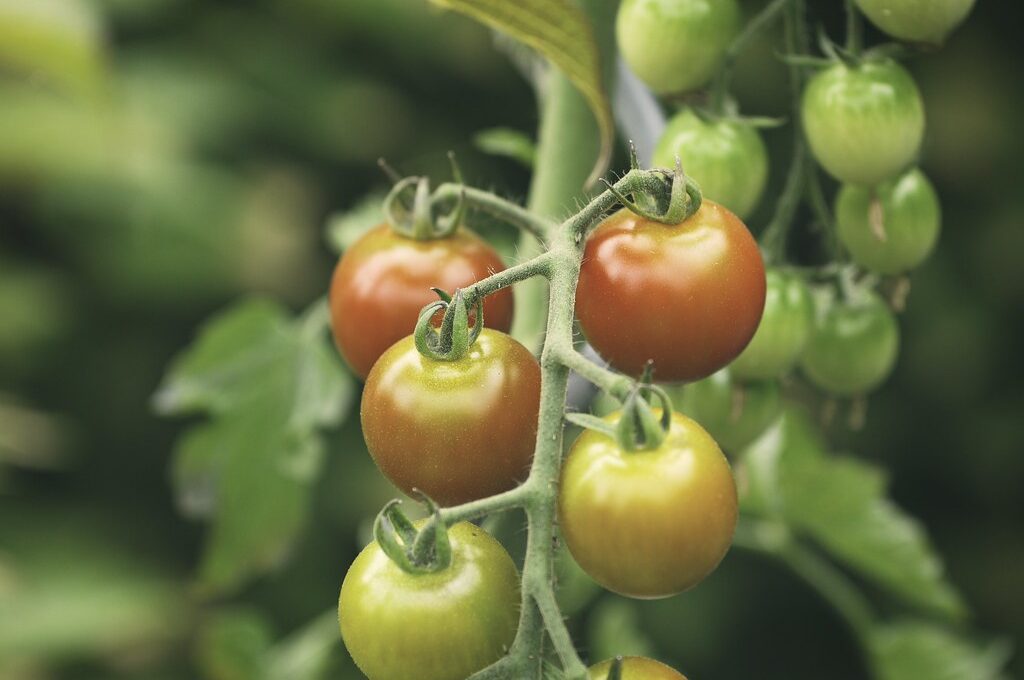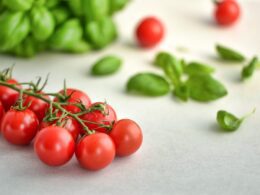You’ve been working hard in your garden, and everything looks great. But you can’t help but notice that your tomato plants are looking healthy but aren’t growing. What’s the deal?
Don’t worry! In this article, we’ll explore why your tomato plants may look healthy but not be growing, and how to fix it. There could be several reasons for this issue – from lack of sunlight to overcrowding. We’ll discuss each one so you can get back to a thriving tomato plant in no time!
Lack of Sunlight
Without enough sunlight, it’s impossible for your plants to thrive and reach their full potential. If your tomato plants aren’t getting enough sunlight, they won’t be able to photosynthesize properly. This will cause them to stay stunted, resulting in fewer flowers, fruits, and vegetables.
Inadequate drainage can lead to limited nutrients in the soil that are essential for plant growth. Poor drainage can also create a waterlogged environment that prevents oxygen from reaching the roots and further hinders proper nutrient absorption.
Without enough light or nutrients, your tomatoes may look healthy but not grow as desired. To get the most out of your plants, you’ll need to make sure that they’re getting plenty of sunshine every day and that there is adequate drainage around the root system. This will help the roots absorb all of the necessary minerals from the soil.
In order to ensure this is happening, you should periodically check on your tomato plants and provide any maintenance needed, such as pruning back dead leaves or adding compost or fertilizer if necessary.
Your tomato plants have a lot of potential if given what they need – sun exposure and well-drained soil – but without these two components in place, they won’t be able to reach their full growth potential. By providing these conditions, along with regular care and maintenance, you’ll see an improvement in both overall health and productivity over time!
Poor Soil Quality
You may have lush foliage and strong roots, yet without quality soil, they can’t reach their full potential. Improper fertilization or inadequate drainage are two of the main causes of poor soil quality that could be hindering your tomato plants from growing.
If there’s too much fertilizer, it can prevent the plant from absorbing essential nutrients from the soil. Poor drainage leads to waterlogged soils, which can lead to root rot.
To make sure your tomato plants get enough nutrition and water, you need to check the pH levels of your soil regularly and supplement with organic matter if necessary. Adding organic material like compost will help improve drainage while providing important nutrients for healthier plant growth.
You should also add mulch around the base of the tomatoes to help retain moisture in the soil between watering sessions.
Taking these steps will optimize both airflow and nutrient retention to create a healthy environment for your tomato plants to thrive, so they can reach their full potential!
Over or Underwatering
Although the tomato plants may appear healthy, overwatering or underwatering can prevent them from reaching their full potential. The soil should have a well-balanced amount of water in it. If there is too much water, the plant’s roots can become saturated and unable to absorb the nutrients they need to grow. If there is not enough water, then the roots will not be able to access any of the necessary nutrients.
Over or under watering can cause soil compaction which reduces drainage and prevents oxygen from reaching root systems. Tomato plants need consistent irrigation so that their roots are able to get just what they require for growth and development. Without proper hydration levels, tomato plants will be stunted or slow-growing and may even die off prematurely due to lack of nutrients.
If a tomato plant does not receive enough hydration it will suffer from wilting leaves which will eventually lead to death as well. Watering your tomato plants correctly is essential for their health and growth. It requires a delicate balance between too little and too much water; however, when done properly, tomatoes will thrive with lush foliage and plump fruit ready for harvest.
To ensure optimal watering conditions, use an appropriate irrigation system such as drip lines that deliver just enough moisture at regular intervals so your tomatoes never go thirsty again!
Pests and Diseases
Observe your tomato plants closely – if you notice any strange spots, bumps, wilting, or discoloration of the leaves or fruit, it may be a sign of pests or diseases.
Pests and diseases are common problems that can prevent your tomato plants from growing properly. To avoid this issue, use integrated pest management (IPM) methods to control pests and keep them away from your plants.
IPM involves using physical barriers like row covers, traps, and sticky barriers; biological controls such as beneficial insects; chemical sprays; and cultural practices like crop rotation and removing affected plant parts.
Additionally, disease prevention is critical for keeping your tomato plants healthy and thriving. Disease prevention strategies include selecting resistant varieties of tomatoes when planting; avoiding overcrowding of plants; rotating crops each year to reduce disease buildup in the soil; providing proper air circulation around the plants by thinning out foliage; watering at the base of the plant instead of overhead watering, which can spread pathogens on leaves; and removing any diseased plant material right away.
These steps will help ensure that your tomato plants stay strong and vigorous throughout their growth cycle!
Could Lack of Fruit Set be the Reason Your Tomato Plants Don’t Grow?
Could lack of fruit set be the reason your tomato plants don’t grow? It’s not uncommon for tomatoes not fruiting despite blooming. Several factors, such as inadequate pollination, extreme temperatures, or nutrient deficiencies, could contribute to this issue. Ensure proper pollination by gently shaking the plants or introducing pollinating insects. Maintain optimal temperatures and provide adequate nutrients to encourage fruit set in your tomato plants.
Overcrowding
It’s important to ensure that your tomato plants are given adequate space to grow. Overcrowding can lead to decreased air circulation and increased disease transmission. A good rule of thumb is that each plant should have an area of at least one square foot in order for it to thrive.
When planting tomatoes, the depth needs to be taken into consideration. If it’s too shallow, the roots may not develop properly. If it’s too deep, the stems will become weakened due to inadequate light exposure.
Fertilizer type also plays a role in how well plants grow. Organic fertilizer is often better than chemical-based because it adds beneficial nutrients while also improving soil structure.
Finally, if your tomato plants look healthy but are not growing, then it might be a sign that they are overcrowded or were planted too deeply. In this case, consider thinning out some of the plants or replanting them at an appropriate depth. Additionally, make sure you’re using the right type of fertilizer for optimal growth. With these adjustments, you should notice improved results in a few weeks!
Temperature Extremes
Be mindful of temperature extremes, as extreme heat or cold can cause your tomatoes to suffer. Inconsistent temperatures, even if they don’t rise or fall to extreme levels, can have a negative effect on the growth of your tomato plants. Nutrient deficiencies may occur due to unstable temperatures, leading to slow and stunted growth.
Here are three important points to consider about temperature extremes when growing tomatoes:
- Keep the soil moist but not soggy; wet roots will rot in too-cold soil.
- Provide shade for plants in hot climates; too much direct sunlight can damage the delicate leaves and disrupt photosynthesis.
- If needed, provide an artificial source of warmth for your tomato plants during cooler months; a heat mat is ideal for this purpose.
It’s essential that you monitor and adjust temperatures on a regular basis if necessary so that your tomato plants don’t become stressed out by sudden changes in their environment. Keeping consistent temperatures is key to ensuring healthy growth and productivity over time!
Frequently Asked Questions
What type of fertilizer should I use on my tomato plants?
To keep your tomato plants healthy and growing, use a combination of pruning techniques and soil amendments. Start by cutting away any dead or damaged branches to encourage new growth.
Then, add organic materials such as compost or manure to the soil around your tomatoes. This will help provide essential nutrients that promote healthy growth.
Finally, fertilize your tomatoes every few weeks with a balanced fertilizer for best results. Incorporating these steps into your gardening routine will ensure that your tomato plants look great and grow strong!
Is there a way to prevent pests from attacking my tomatoes?
You can take preventative measures to protect your tomato plants from pests. Consider companion planting with other veggies and herbs that repel insects. For instance, marigolds emit a scent that wards off many insects and make a great companion plant for tomatoes.
Also, make sure to keep the area around your plants free of weeds and debris that can provide habitat for pests. Taking these proactive steps will help ensure your tomatoes stay healthy and continue growing!
How often should I water my tomato plants?
Watering your tomato plants is an important part of keeping them healthy. It’s best to water the tomatoes deeply and infrequently – about once a week is ideal. However, how often you water depends on factors like the amount of sun exposure they get, the soil type, and temperatures.
If you’re unsure when to water your tomatoes, simply stick your finger into the soil around each plant; if it feels dry two inches below the surface, it’s time to give them some water. With proper sun exposure and timely watering, your tomato plants will start growing in no time.
What type of soil is best for growing tomatoes?
You need the right type of soil to grow healthy tomatoes. A well-draining, nutrient-rich soil is best for growing tomatoes. Make sure your soil has a pH level between 6.2 and 6.8 to ensure optimal growth.
Plant your tomato seeds at least 1 inch deep in the soil and water them thoroughly but not too often so they don’t become waterlogged. Ensure that your plants get at least 6 hours of sun each day for healthy growth and maximum yield.
How do I know when to harvest my tomatoes?
Harvesting tomatoes is a fun and rewarding process. To know when to harvest your tomatoes, look for signs of maturity such as the tomato becoming larger and changing color from green to red. The plant should also be free of disease or any other signs of distress.
Additionally, make sure the tomato has achieved a balanced nutrient content by monitoring the taste and texture. When you’re confident that your tomato is ripe, it’s time to pick it!
With careful attention to detail, disease prevention, and nutrient balance, you can enjoy fresh tomatoes all season long.
Conclusion
It’s hard to see your tomato plants not thriving, but there are likely several factors at play. Take a closer look at the environment they’re in and make sure it’s suitable for growth. Check for lack of sunlight, poor soil quality, improper watering, pests or diseases, overcrowding, and temperature extremes.
If you correct any of these issues, your tomatoes should start growing again! Don’t give up; a few simple changes could be all they need to thrive.









